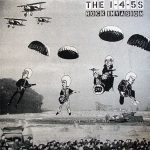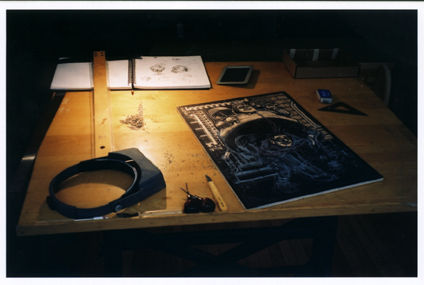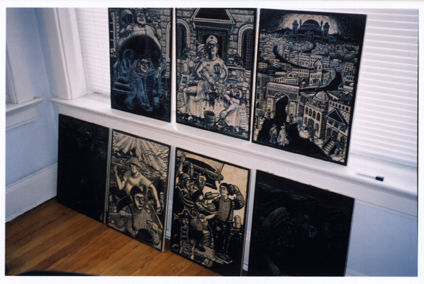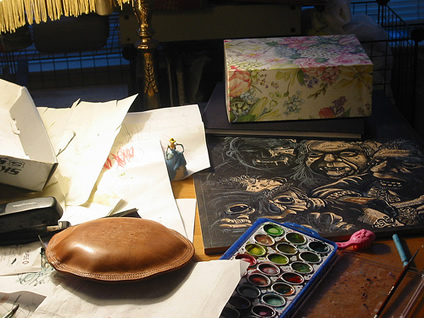What exactly is a Theremin? Well I’m glad you asked that question, because that will allow me to use the BLOCKQUOTE function in my HTML document. Here’s an excerpt from the Big Briar Information Bulletin No. 9201A:
The theremin is one of the very first electronic musical instruments, and yet it is one of the most novel and original. It is played without being touched. The instrument responds instantaneously and continuously to the motions of the player’s hands in the space surrounding it. The instrument’s tone at times resembles that of a violin, cello, or human voice, but has its own unique ethereal quality.
The theremin was developed in the 1920’s by the Russian physicist Lev Sergeivitch Termen (anglicized to Leon Theremin). The Radio Corporation of America produced a limited number of theremins during the late 1920’s under license from Professor Theremin. Then, during the 1930’s, Professor Theremin formed his own company in New York City to further develop the theremin, as well as to design and build other, more experimental electronic musical instruments. Theremin returned to his native Russia in 1938.
The theremin is played by standing at arms length from the instrument and moving one’s right hand towards the vertical antenna to increase the pitch. The player’s left hand is held about a foot above the curved volume antenna. As this hand is moved closer to the antenna the volume decreases. The size of the fields of both antennae can be altered as well as the waveshape of the sound. The distinct theremin sound is unmistakable and has been used for years as background music in various movies. The eerie sound lends itself to sci-fi and horror flicks, most notably The Day the Earth Stood Still. As well, it has appeared in many recorded songs. Perhaps the best example is that ghostly sound during the chorus of the Beach Boy’s Good Vibrations (I’ve been recently informed that the Theremin-like sound is not a traditional space-controlled theremin. It is actually a similar-sounding electronic instrument called an electro-theremin). To learn the almost complete story of Theremin and his electronic adventures rent Theremin: An Electronic Oddessy.
Where to Get a Theremin:
The company I ordered my theremin from was Big Briar. This is a company started by Bob Moog, inventor of the Moog Synthesizer. They sell high quality theremins (the now discontinued 91 Series A,B+C, were priced in a range from $2500-$3050 and they now have a MIDI capable theremin called the Ethervox MIDI Theremin and it goes for $3500). If your looking for a starter model, as I was, I highly recommend starting with the Etherwave Theremin Kit ($299). It also comes fully assembled for a price of $369. Although putting together something that you know you will be plugging into a wall may seem scary at first, I would suggest buying the unassembled kit to save money and its much cooler to say to your friends (who will already be impressed by the fact that you own a theremin) “Hey I built this all by myself!” I began to see Etherwave popping up all over. Most recently I saw Man or Astroman? in concert and it seems that Coco EMW has upgraded from his flimsy pitch-only theremin to a strapped-on, black Etherwave model! When you buy the kit it comes with an unassembled theremin, a video on how-to-play (hosted by Lydia Kavina), a Clara Rockmore CD, and a booklet on the history of the theremin. If you’d like more info or just want to order your theremin today write or call Big Briar at:Big Briar, Inc.
ELECTRONIC MUSICAL INSTRUMENTS
554-c Riverside Drive
Asheville, NC 28801
(800)948-1990
info@bigbriar.com
Having no real electrical engineering skills, I was a bit nervous about having to assemble the theremin. It was, however quite an easy process. Read on and relive my assembling experience in the next section…
Putting Together my Etherwave Theremin:
Well, it took about three month’s but I finally received my theremin from Big Briar. It was a Monday morning when I got a buzz from the delivery guy. As soon as I got the box up to my place I carefully knifed it open. At first glance it seemed as though putting it together was going to be a major task. The package contained two pre-assembled sections of the wood case, a bubble pack with a circuit board enclosed, two bags of miscellanies parts, and the two shining antennae. The first step in assembling the kit was to stain the wood case. It seems every other person who I’ve seen playing an Etherwave has gone for the shiny all-black look. Personally, I think this looks cheesy, like something Quiet Riot would use, and prefer the wood-grain look. The wood seems to evoke 1917 a bit more than Ibanez black! For my stain I just got some Minwax stain (with the poly-stuff pre-mixed in) and brushed it on. This is the only step where I goofed pretty noticeably. The key here is to apply the stain very thinly. Take the time to get gradually the darkness you need. I was impatient and applied the stuff heartily. When it came to steelwooling the surface to place my second coat on the areas that were too thick just chipped off. This whole process can take about 16-24 hours to allow all the coats to dry thoroughly.
The next step was fastening the two antennae to the cabinet. I needed to buy epoxy for this step. This whole process is simple enough. You just tighten a couple of bolts and there you have it. Make sure your pitch antenna is vertical before the epoxy dries. Mine is ever so slightly off (but it works just fine). Really once I got all the parts laid out it didn’t seem as complicated as I first thought. In fact, most of the steps are just putting in screws. At this point I also had to stick a provided piece of foil into the interior of the cabinet and (this was one of the most difficult parts) peel some self-adhesive felts to be placed on the feet of the unit.
The next major step was putting the front panel together. No big whoop, just screw a couple of nuts. You do need a very small flat-head screw driver to tighten the knobs on the front. I had to settle with the tweezers from my pocket knife.
Finally, I had to wire the unit and solder the connections. I made sure to buy a wire stripper so I wasn’t destroying my wires with my ineptness (’bout $5.00). The directions are pretty straight forward as to where to put what wire. The pieces are small so be sure and have a needle-nose pliers handy. Tinning the wires took the longest amount of time. The actual soldering was fairly easy compared to the tinning step. My only problem was when I was soldering the pitch wire to the circuit board the connection on the board got to hot and started to shift. Luckily I removed the heat before I raunched it. During the summer of 1997 I did some of my first recordings using my theremin. I am, admittedly, a really poor thereminist, and in 2 out of the 3 songs I used it on, the theremin is used mostly as a sound effect. I’m debating whether I should contaminate the net with my recordings.








